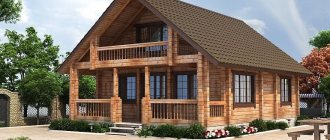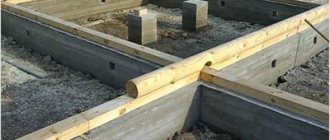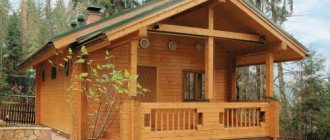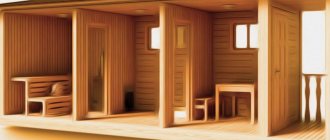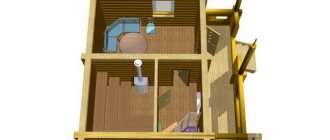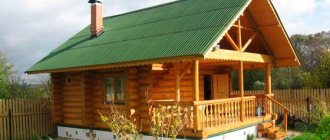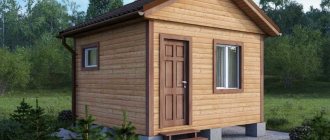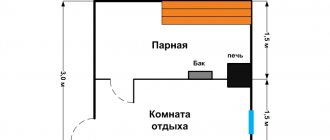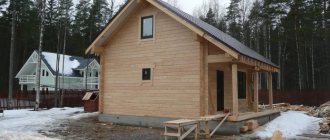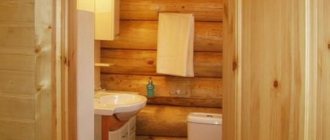Telegram
VK
Viber
If the area of a suburban area does not allow for the construction of a large building, you will be interested in the layout of a 3 by 3 bathhouse inside, as in the photo below. By choosing one of the simple options, you can build a dressing room along with a steam room, even in a small area. But in order for the bath structure to be functional and work well, it is important to take into account some nuances.
Advantages of a bathhouse measuring 3x4 m
Building a bathhouse from 3x4 timber with your own hands is an undertaking that does not require large budget expenditures or the involvement of heavy construction equipment. With the help of a competent project and high-quality materials, 1-2 adult men can raise a structure in a few weeks.
Choosing a wooden block as a building material makes the process of assembling the box no more difficult than a children's construction set. The correct geometric shape makes it easy to construct elements into crowns. With reliable fasteners, construction of a high-quality foundation and insulation work, your own bathhouse will last at least 20 years with timely repairs and maintenance.
The construction of a bathhouse with dimensions of 3 by 4 m from timber material is characterized by the following advantages:
- The building area is only 13 sq. m. m with allowances for foundation protrusions and roof slopes;
- possibility of construction in limited space;
- a full-fledged building for washing and resting for 2 adults or 1 adult and 2 children;
- the ability to organize a separate steam room, washing room and dressing room;
- speed of construction;
- low consumption of materials;
- there is no need to install a strong foundation;
- It’s easier and faster to insulate, decorate, warm, and dry a small room.
The wood from which it is planned to build a mini-sauna complex on your own site is an environmentally friendly and affordable material. Thermal procedures in a room built from timber have a beneficial effect on the overall tone of the body, strengthen the immune system, have a healing effect on the pulmonary system and skin, and promote recovery from colds.
Baths 3 by 3: photos, projects, interior
This bathhouse is a small structure that is well suited for a summer residence. It has a capacity of 2-3 people, which is enough for a couple with a child.
Advantages of a small sauna:
- compactness. It will easily fit even on a small plot of land;
- low construction cost. Low consumption of materials significantly reduces the cost of building a bathhouse;
- quick warm up. A small room is heated faster and retains heat longer, which also reduces fuel consumption;
- ease of construction. It’s easy to build a 3x3 bathhouse, so you can build it yourself without turning to specialists;
- fast construction speed. The construction of the bathhouse will take a little time, which will allow you to quickly start using the steam room.
Despite the fact that the 3x3 bathhouse project is small in size, it is quite possible to accommodate all the necessary premises. When drawing up a plan, it is best to divide the building into two rooms (one should be larger). A larger room will contain a steam room and a sink, and the other will contain a dressing room and a dressing room.
If you look at the 3x3 bathhouse projects, photos, you will notice that most of the buildings are an ordinary one-story building. Less often they make a bathhouse with an attic or a two-story one.
In the first case, the bathhouse has an area of 8-8.5 square meters. The building has several rooms:
- steam room - 4-5 square meters;
- shower room – 2 square meters;
- dressing room/rest room – 2-3 square meters.
In this project, the dressing room is combined with a rest room and has a small area. It is recommended to install a folding table, which will help save space.
The bathhouse with an attic has an area of about 14-15 square meters. The second floor is used as a recreation room. If you place a 3 by 3 bathhouse in your country house, you can make it a guest bath. In this case, it will be convenient to stay overnight.
Thanks to this compactness, 3x3 bathhouse projects in the country are especially popular. Photos of summer cottages presented on the Internet prove that most have a small area, about 6 acres in size, where it makes the most sense to install a small bathhouse.
We recommend reading:
Project of a garage with a bathhouse: construction features and choice of material
When developing a 3x3 bathhouse project, you need to indicate on the drawing the location of all partitions, windows, doors, think over the drainage system, ventilation and arrange lamps with sockets. You need to indicate all dimensions and check whether they comply with the standards.
If you find it difficult to draw up a project yourself, you can turn to specialists. Also ready-made projects, photos of 3x3 baths are presented on the Internet. You can also find photos and videos online that show the implementation of a specific project.
The drawing also helps to calculate the amount of materials required to build a bathhouse and find out the approximate cost of the future structure.
Peculiarities
When building a compact bathhouse, use standard lumber - planed timber with a length of each product of 6 m. Manufacturers produce wooden products processed on four sides of this particular molding. When erecting walls 3 m wide, the timber will only need to be cut in half, which will speed up the construction process and make the work easier.
Important!
To comply with fire and sanitary safety, ensure the recommended distance from the facility to the adjacent territory and buildings. There must be at least 1 m between the fence and the bathhouse, and at least 15 m from neighboring buildings.
Before starting construction work and design, check out the photos of finished baths measuring 3 by 4 to choose the option that suits you. After choosing a building model, the design and construction stages will not be difficult. Due to the compactness of the bathhouse complex, carefully consider the layout of the premises, the location of the heating stove, window openings, and entrance groups.
Choosing a place
- It is advisable to build the building on a hill, but not opposite the main house. You should not build next to the road, and location close to neighboring buildings is prohibited. By law, you can place your bathhouse no closer than 8 meters from your neighbors’ bathhouse.
- It is advisable to have a pond, pool or other body of water nearby. Then you can fully enjoy swimming after the steam room. You can use an alternative method by digging a very small bathing container or placing a barrel.
Note! The easiest solution would be to set up a dousing station, where a bucket of cold water is suspended above height level. The user who has been steaming will only have to pull the string, and a tub of cooling moisture will tip over onto him.
- You can decorate the area around with your own hands by planting a hedge or other shrubs. This will create an intimate atmosphere and hide vacationers from prying eyes.
- Consider fire safety. Do not place the house near a shed, wood shed, or garage. Be sure to coordinate the project with the relevant authorities. In the vast majority of cases, baths are built of wood, and all safety measures must be carefully observed.
Bathhouse 3x4 m: basic information about the project
The construction of a dacha mini-complex is classified as the construction of outbuildings on a private plot and is regulated by the state-approved document SNiP 30-02-97. Study building and sanitary standards before choosing a place to build a structure to ensure fire and hygienic safety.
You need to build your own bathhouse on the most suitable territory. To do this, you need to analyze the following aspects:
- soil type. Choose non-swampy, flat areas for construction. The choice of type of foundation layer depends on the nature of the soil;
- depth of the aquifer. Assess the area after snow melts and when groundwater levels drop. The foundation must not be washed away;
- climatic features of your region. Analyze the freezing depth of the soil substrate, the threat of flooding and seismic activity to select a reliable foundation for construction that will ensure long-term operation of the building;
- location relative to other objects on a summer cottage or private plot. Draining water from a bathhouse, drawing water, heating requires compliance with sanitary and fire safety;
- electrification. The supply of electricity must be carried out from a common panel that supplies a residential or country house and other objects on your territory;
- harmony with the overall landscape of the site. Ensure that the building fits organically into the overall appearance of the territory, its appearance is combined with neighboring objects.
The architectural aspect of construction in the area where your site is located plays a big role. When constructing a bathhouse on residential land, it is necessary to coordinate the upcoming construction activities and obtain permission from state administrative bodies before the construction process.
What must be in the bathhouse
The presence of bath paraphernalia depends on the preferences of the owner. In the traditional version, there must be a soap set for both sexes, if there are preferences in products. The sink should have a washcloth for each family member, sheets and sheet set. A basin, tub or font must also be present. The presence of logs, bath caps and a broom will create coziness and completeness of the interior.
A thermometer is necessary if there is a person in the family with heart disease. Scents are not required, but you can purchase flavors or use spruce branches to lift your mood. The necessary premises include a wash room, a steam room and a dressing room. The rooms are connected to each other or lead out into the main corridor onto the terrace. A living room or block house is located in large saunas.
The canopy should not occupy more than a third of the steam room or sink. In some bathhouses, the floor is cold or does not warm up enough, so they came up with a ladder or foot tray that can be removed if there is not enough space. The steam room requires a separate tub with a broom and stones for supplying steam. A water supply is installed for hot water and a tank is installed, which takes up unnecessary space.
Nuances of designing basic elements
A project for the construction of a small-sized bathhouse is one of the most important documents, according to which you can systematically carry out construction processes, calculate the amount of materials, obtain a construction permit, and register the constructed structure for cadastral registration.
Proper planning of a small-sized building will allow you to obtain a large usable area and provide for all the necessary aspects. At the design stage, it is necessary to take into account all the points in order to organize consistent construction without missing deadlines.
Project
Designing your own bathhouse is an important link in the chain of construction processes. Create a competent project yourself or take ready-made options. Complete your sketch using special computer drawing programs or draw it on paper. For the drawing, take millimeter or checkered sheets and draw according to scale.
The project for which construction work is planned will require the following types:
- lateral view;
- front view;
- view from above;
- sectional view;
- view in three planes.
On all projections, indicate the dimensions of all elements - foundation, walls, rafter system, location and dimensions of windows, doors, heating stove, shelves. A well-drawn project will help to accurately calculate the estimate and become a plan for completing the work.
Foundation
A timber structure with dimensions of 3 by 4 m does not require the organization of a powerful foundation. Wooden building with an area of 12 sq. m of timber weighs from 2 to 3 tons, depending on the stage of drying of the lumber and the weight of the roof. The foundation must ensure reliable immobility of the structure. This is the main condition that will increase the service life of the building.
To build a small-sized bathhouse, the following types of foundation are used:
- monolithic filling. Dig a rectangular pit on the site with a depth of 30-40 cm, a length of 4.5 m and a width of 3.5 m. Equip the formwork from boards at a distance of 20-30 cm above the ground surface, fill the bottom with a cushion of stove and gravel, organize drainage , fill the space with concrete using M200 or M250 cement. Depending on weather conditions, it will take from 2 to 4 weeks to dry the base;
- strip base. Organize the excavation of a trench for the bathhouse foundation, repeating the perimeter of the structure being erected, 30-40 cm wide and 30-35 cm deep. Put together a formwork structure from plywood or boards with the walls rising 20-30 cm above the ground surface. Equip a drainage drain or pipe drainage for cleaning water . Fill the formwork space with a mixture of cement, sand and water. Use a cement composition of at least grade M200. To strengthen the structure, use reinforcement, pour broken bricks, stones, and coarse crushed stones into the concrete composition. It will take up to 3 weeks to dry the foundation tape;
- block foundation. Level the site for construction, dig at the planned corners of the bathhouse, as well as in the middle of the length and width of the perimeter, recesses for concrete blocks. Fill the bottom of the holes with a sand and gravel cushion 10-15 cm high, lay stone elements, and compact with soil. Make sure that the level of all block racks is the same;
- pile-screw field. Make markings on the soil substrate for installation of screw support piles. Install screw-type steel supports at the corners of the building, as well as one post under each wall. When planning to build load-bearing walls inside the box, consider installing a screw pile in the middle.
Important!
At the stage of organizing the foundation for the bathhouse, provide for the removal of waste water from the washing compartment. The base must not be washed away.
When building a bathhouse with a heavy brick heating stove, consider pouring a separate foundation. In accordance with the project, make a mark on the ground in the place where the heating unit will be installed, dig a recess, organize pouring concrete formwork or placing blocks.
Walls
After the foundation work, begin constructing the timber box. Make a powerful tier on the base from timber of a larger cross-section than that used for the walls. Place a grillage on the pile-screw field.
Assemble the frame in the following sequence:
- lay a waterproofing layer (for example, roofing felt) on top of the foundation row;
- for the first crown, use a wooden block 200 x 200 mm or 300 x 200 mm. The first row will bear the heaviest load of the log house, so the use of thicker material is required. Treat the laid tier with antiseptics, impregnations that protect against fungus, rodents, and insects;
- lay walls from timber, collecting right angles or organizing removal. Please note that the added corner elements will require more lumber;
- between the tiers, lay insulation - jute tape or moss;
- secure the rows together with dowels;
- To save money, immediately take into account the location of windows and doors.
| Bar height, mm | 150 | 200 | 250 | 300 |
| Number of tiers | 17 | 13 | 10 | 8 |
| Number of bars | 40 | 30 | 23 | 19 |
The standard height of the box must be at least 2.5 m. The number of rows of timber depends on the selected section of lumber. To assemble a 3 x 4 log house you will need at least 6-7 cubes.
Partitions
Partition structures that delimit rooms inside a log house can be made from wooden blocks of a smaller cross-section, boards, or using frame technologies. The bath space should be divided into:
- dressing room or rest room (2 by 2 m);
- washing room (1 by 2 m);
- steam room (2 by 3 m).
There is no need to construct additional load-bearing walls due to the small size of the building. The construction of solid partitions will reduce the usable area. Divide the space inside the bathhouse in compliance with tightness and fire safety to ensure complete washing procedures with rest.
Roofing system
For a small bathhouse, you can build a roof with one or two slopes. For construction, you will need an unedged board with a thickness of at least 5 cm for installing rafters, lumber of at least 2 cm for organizing the sheathing.
Install the roofing system as follows:
- Build rafters above the log house in increments of 0.7-1 m;
- Install a sheathing on top of the rafter elements, laying boards every 25-30 cm;
- secure the rafter spans with crossbars;
- lay a waterproofing layer on the sheathing;
- Lay roofing materials (slate, ondulin, corrugated sheets, tiles, etc.) on top of the waterproofing.
Provide an outlet for the chimney pipe in the roof. Equip all elements of the rafter system with reliable metal fasteners and corners. When installing roofing material, use hardware with polymer washers. After shrinking the frame, sew up the gables with boards or OSB panels.
Floors and ceilings
After assembling the box and erecting the rafter system, proceed to laying the floor. For high-quality insulation and tightness, you will need to build logs, a subfloor and a finishing coating. Provide for drainage of waste water in the washing compartment. Install a drainage ditch or pipeline under the washing area to remove wastewater from the structure.
Assemble the floor in the following sequence:
- on the protrusion of the lower tier, in specially cut recesses, lay logs with a thickness of at least 5-7 cm and a pitch of 0.5-0.7 m;
- lay a rough board under the joists, forming a continuous covering;
- lay waterproofing over the subfloor;
- put insulation (stone wool, polystyrene foam boards, etc.) in the spans between the joists;
- sew up the insulating layer with waterproofing;
- Finish with a planed floorboard.
In the washing compartment, provide a cover that reliably protects wooden materials from waste water. You can make a concrete screed under the final flooring. When covering the floor with washable tiles, arrange a slope of 3-5 degrees with the collection of wastewater into the pipeline.
Construct ceilings immediately with an insulating layer. Place logs on the top crown, and sew them up with clapboard from the inside of the room. Cover the top of the finishing in the attic with a layer of waterproofing, lay fireproof insulation on top, and cover it with a waterproofing layer. Place an unedged board on top of the insulating “pie”. Cover the smoke exhaust pipe with fire-resistant materials.
Windows and doors
Install entrance groups and window frames after shrinking the assembled box. It will take at least 1 year to completely dry the timber and stop deformation processes.
For a small bathhouse, you can install a window only in the washroom with dimensions of 50 x 50 cm or in the recreation room with dimensions of 70 x 70 cm. Due to the low temperature in the washing room, it is possible to use PVC structures. Wooden window elements will need to be treated against moisture. It is not advisable to install windows in a steam room due to the possibility of heat leakage.
Important!
When installing window frames and door structures, use fireproof foam to fill voids.
Install doors between rooms from solid aspen or larch. Use door handles with wooden linings to eliminate the risk of burns when touching metal elements. The bathhouse will require an entrance door (wooden or metal) and two entrance groups for a washing room and a steam room.
Bake
To heat a small wash room and steam room, you will need a small heating stove heated with wood. Choose compact options to get more usable space, ensure fire safety and avoid burns. Provide proper removal of smoke from the room.
For a bath measuring 3 by 4 m, you can install:
- a brick oven with one wall removed to the washing compartment. To build a heating structure made of bricks, the foundation will need to be poured in advance;
- homemade stove from a barrel. The unit inside must be divided into compartments for combustion, smoke removal, water heating, and ash collection. When using bricks inside a structure, consider constructing a free-standing foundation;
- a finished metal stove made of steel or cast iron. Installation of factory models does not require installation of a base.
A sauna stove must perform several functions - heat the room, water, stones to create steam. Depending on the option chosen, provide fire protection for wooden elements. A flood sheet must be installed in front of the stove, and the walls adjacent to the structure must be covered with asbestos or metal. For the chimney, choose stainless steel pipes.
How to plan a sauna with a steam room and a sink
With a limited construction area, several questions always arise. First: is it advisable to divide the house with 3x3 walls or partitions? In practice, there are often projects without partitions, when the sink and steam room are located in different parts of the house. If desired, you can equip two separate rooms, dividing the washroom and steam room with a wall. Both options are good and feasible in any conditions, so it’s better to consider both:
- separate arrangement of steam room and sink;
- steam room and sink together.
In practice, it will not be possible to do without difficulties, but with skillful planning of the premises you can “get out” of any situation and build a worthy alternative to larger buildings.
Separate arrangement of steam room and sink
When planning a 3x3 bath, the sink and steam room can be located together. Before construction, you need to understand how you will use the vestibule or dressing room. To arrange a small room in it, you will need to reduce the total area of the steam room and sink. There is a way out: divide the vestibule and the main room of the bathhouse into two equal parts. It's another matter if you want to use the vestibule as a hallway where you can leave clothes and belongings. In this case, a minimum amount of space is allocated to it, trying to leave more space for the washing room and steam room, combined with each other.
When arranging small steam rooms, you need to pay special attention to the design and power of the stove. A small room can easily overheat. To avoid overheating, install the oven with a power regulator. When combining a steam room with a washing machine, high humidity cannot be avoided, as well as high temperatures (70, 90 C and above). It will be uncomfortable to wash at such temperatures, but in a small area it is difficult to equip a full-fledged bathhouse with a brick oven or stone lining. If possible, increase the size of the steam room so that it contains brickwork for a small stove. Sometimes owners of small sauna houses adapt to “controlling” the stove. They manage to maintain a temperature in the room suitable for a full wash after the steam room.
Steam room and sink together
If you design the sink and steam room separately, you will have to slightly expand the original plan. It should be made more than one meter, and then you can separate the washing and steam rooms with a small partition. Only a meter will be allocated for the washing area, without taking into account the thickness of the walls. You will get a steam room of a decent size if you reduce the relaxation room or remove it completely, leaving a small dressing room.
Important! The door leading from the steam room to the courtyard should always open outward. This will make it easy to knock it out if it overheats.
Materials for building a bathhouse
To build your own mini-sauna complex you will need the following materials:
- materials for the base (concrete, formwork, brick, blocks, screw piles) depending on the selected type;
- a block of wood with a cross section of 20 x 20 or 30 x 30;
- wooden beams for walls with a cross section of 15 cm;
- lumber for partitions - a block with a section of 10 x 10;
- logs for the floor, rafters and ceiling with a thickness of at least 5 cm;
- unedged board for the subfloor, sheathing and ceiling, at least 2 cm thick;
- waterproofing;
- insulation material (stone or mineral wool, polystyrene foam, fiberglass, etc.);
- lining for interior decoration;
- edged boards for floors, ceilings, installation of shelves;
- 1 entrance and 2 internal doors;
- window;
- fittings (hinges, handles, latches, locks);
- fasteners (pins, nails, screws, rubber washers);
- metal sheet for fire safety;
- electrical wiring protected from moisture;
- heat- and moisture-resistant lighting fixtures;
- antiseptic;
- polyurethane foam;
- jute or moss for insulating a log house;
- roofing materials.
Wooden materials for high-temperature rooms should not release resin. Choose aspen lumber for finishing the steam room. Use coniferous wood in the wash room or rest room.
Sauna stoves with separate firebox, sink, steam room
When the furnace, steam room and sink are equipped separately, the furnace firebox is removed to the rest room. Heat spreads throughout the house, and whether there will be enough of it depends on the time of year, the power of the stove and the height of the ceilings. Wall insulation plays an important role in heat conservation. There are good examples when the sink and steam room are located separately: they can be found in the photo.
Sometimes one side of the stove is taken to the washing room. This practice is used when laying out brick kilns. The wash room is also heated using a tank that heats the stove. In a small room it makes a good natural heater. If the condition of the electrical wiring allows, the use of electric heaters is allowed. You can also equip a mini-system of heated floors.
It is best to install a stove with a power regulator in a small bathhouse. This will help avoid overheating. Power regulators are provided in gas and electric ovens. Supporters of traditions do not like such “innovations” and prefer to use wood heating. It has already been mentioned that you need to be able to handle a brick oven. If you have certain skills, a person can handle wood heating.
Work order
Consistent execution of construction processes is necessary to obtain a reliable structure that will last at least 20 years. Check out the step-by-step construction of the bathhouse in the video, which shows the main points of the construction of the structure.
The process of building a bathhouse consists of the following important steps:
- drafting;
- obtaining permission to construct a facility (for construction work on urban lands);
- calculation of construction materials estimates;
- purchasing everything necessary;
- preparation and marking of the territory;
- arrangement of a drainage pit or wastewater disposal structures;
- organization of the foundation, including for a heating stove;
- assembling a box from timber;
- construction of a rafter system;
- roof installation;
- building shrinkage;
- installing doors, windows, installing a stove;
- electrification works;
- construction of shelves, static structures;
- finishing activities.
Consistent implementation of all activities will allow you to independently build a small bathhouse for comfortable relaxation and washing procedures in a short time. Pay attention to every step to satisfy all requests. Subsequently, you can add a veranda, porch, or terrace to the structure.

